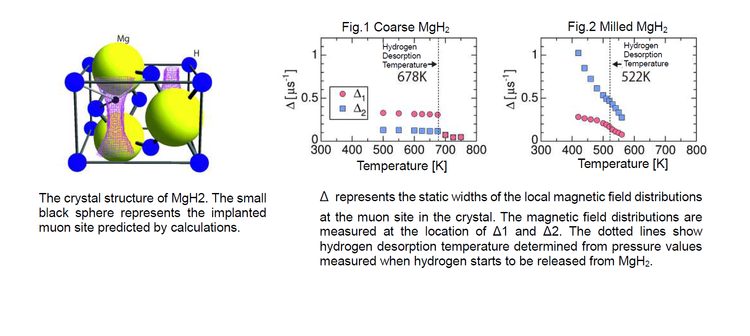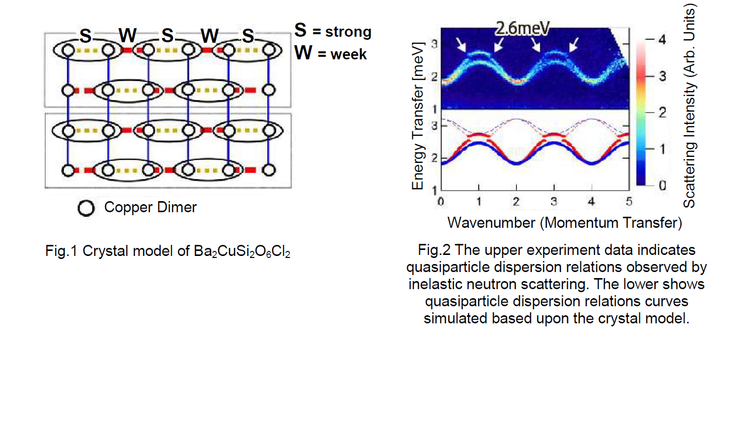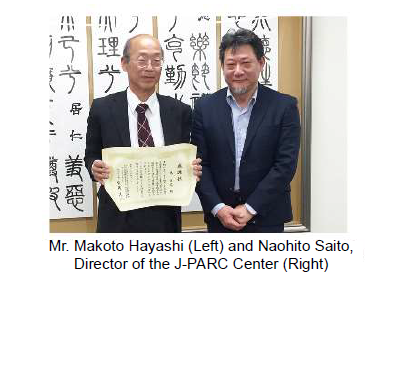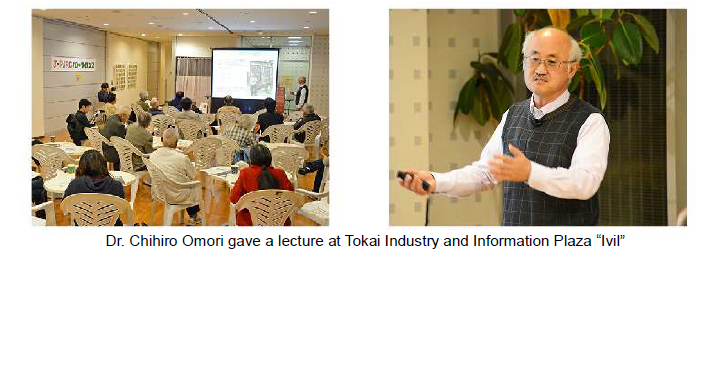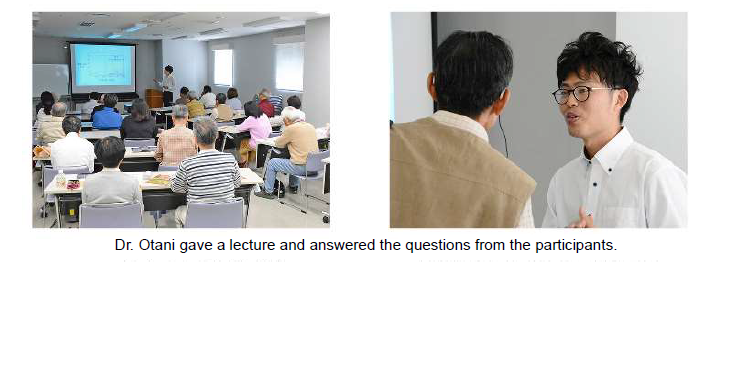J-PARC NEWS May 2019 (Issue #169)
■Observation of the Mechanism of the Hydrogen Desorption Reaction in a Hydrogen Storage Material with an In-Situ Observation Technique using Muons (April 12, Press Release)
One of the key issues to realize the hydrogen-based society is how to find useful hydrogen storage materials, which desorb and absorb hydrogen at around room temperature. To study the mechanism determining the desorption temperature (Td) of hydrogen storage materials, we have measured positive muon spin rotation and relaxation (m+SR) in MgH2 up to above its Td together with the pressure in the sample space. Such an in-situ measurement has been recently available for various materials due to the development of the pulsed muon beam and counting system. Here, m+SR provides local magnetic environments through the change in the initial muon spin polarization, which is antiparallel to the muon momentum due to parity violation in the weak interaction.
In fact, m+SR measurements reveal that the internal magnetic field (D) is static until Td for the as prepared coarse MgH2 sample. On the other hand, for the milled MgH2 sample with Td lower by about 150 K than that of the coarse MgH2, the internal magnetic field decreases with increasing temperature even well below Td. This indicates the occurrence of hydrogen diffusion well below Td. In other words, since such diffusion enhances the desorption reaction through the removal of reactant, i.e. H from the system, Td is found to decrease with milling. Such information is useful to search a novel hydrogen storage material in the near future.
■Successful Observation of Topological Quasiparticles in a Quantum Magnet - Prediction of a Topologically-Protected Magnetic Quasiparticle Edge State - (May 8, Press Release)
In recent years, research has progressed in the area of topological insulators--a new concept incorporating topology into condensed matter science. These materials exhibit a number of phenomena completely at odds with previous common sense, such as a state allowing current flow on their surface while not allowing internal current flow, and they have the potential to change our lives through the advent of new, energy-saving materials for information transfer using these new effects. It has been shown that this concept can be adapted not only to electrons in crystals, but also to the spin produced by electrons (the characteristic that serves as the basis for magnetic properties in a substance, produced by the angular momentum of electrons), and related research is underway targeting magnetic materials. Through this research, the possibility was suggested that, in a magnetic material, barium copper silicate (Ba2CuSi2O6Cl2), the spin state (called a dimer) in which electron spins of copper ions in two layers (upper and lower) in the crystal are coupled behaves in the same way as electron spin in a topological insulator. When the dimer takes in energy, a quasiparticle (quantum-mechanical virtual particle) called a triplon is produced. To understand the properties of these triplons, this experiment carried out detailed measurement of the relationship (called the dispersion relation) between the energy taken in by dimers and the energy's wavenumber (momentum) using the AMATERAS inelastic neutron scattering spectrometer at J-PARC. The distinguishing characteristic of the dispersion relation obtained this time (Fig. 2) is a break in the curve near 2.6 meV and the presence of an energy gap in the interval. It was found that this can be explained if it is assumed that interactions between dimers in the layers of the crystal (Fig. 1) repeat in an alternating strong-weak pattern. It was determined that the pattern where electron spins have the same interaction is one typical model of a topological insulator. Observation showed that this material is a topological magnetic material, and there is a possibility that a remarkable state occurs in the material where spin flows in a way similar to how current flows on the surface of a topological insulator. If it becomes possible to use this spin flow, there will be no energy loss due to Joule heat, as happens in the case of electric current, and this may lead to the development of materials to transmit information with even more outstanding energy-saving properties.
■Certificate of Appreciation Presented to Dr. Makoto Hayashi (April 24)
Dr. Makoto Hayashi has consistently made major contributions to the promotion of industrial utilization of the Materials and Life Science Experimental Facility (MLF) at J-PARC, and this March he retired from the Comprehensive Research Organization for Science and Society (CROSS). The J-PARC Center presented Dr. Hayashi with a Certificate of Appreciation in recognition of his distinguished service. Dr. Hayashi was active in the planning department of Ibaraki Prefecture, and later as a science coordinator at CROSS. More specifically, he worked as the head of the secretariat from the beginning of the Industrial Users Society for Neutron Application, and through activities like holding numerous research meetings and conferences to report results, he promoted interaction between industry and academia, and put his heart and soul into expanding the utilization of neutrons. Taking Dr. Hayashi's contributions as an opportunity, the J-PARC Center has established a system for presenting Certificates of Appreciation to outsiders who have made major contributions to J-PARC. Dr. Hayashi became the recipient of the first certificate to be presented, a notable achievement.
■J-PARC Hello Science "From High Intensity Proton Acceleration to Train Acceleration" - Wide-Ranging Applications of Broadband Cavity Systems - (April 26, Tokai-mura Industry and Information Plaza "iVil")
At a Science Cafe on April 26, Dr. Chihiro Omori (KEK Professor) of the Accelerator Division served as the instructor, speaking on the "broadband cavity systems" used at J-PARC. One key technology for realizing the high intensity beam at J-PARC was a proton beam accelerator called a broadband cavity, developed by the Cavity Development Group of Dr. Omori and others. Fabrication technology was established by developing magnetic materials for the cavity and improving performance of heat treatment, and this technology is in use not only at J-PARC, but also at many circular accelerators at the European Organization for Nuclear Research (CERN), the location of the LHC, the world's largest accelerator straddling the countries of Switzerland and France. Furthermore, attempts are being made to expand to a broader range of applications for consumer use, such as development of energy-saving transformers for railways. Dr. Omori explained a wide variety of topics, from the principle of acceleration to examples of its applications.
■Bus Tour of Recommended Experiences in the Central Prefecture -- Participants Visit J-PARC (April 28, J-PARC)
Ibaraki Prefecture plans bus tours of various sites in the prefecture called the Ibaraki Yoitoko Plan. On April 28, there was a bus tour of the central prefecture called "Trip to the Center of Ibaraki: A Field Trip for Adults Featuring World-Class Superb Scenes of Nemophila ("Baby Blue Eyes") Flowers, a Cutting-Edge Research Facility, and a Long-Established Sake Brewery." Capacity of the tour was exceeded, with 40 participants from both inside and outside the prefecture, and they visited J-PARC as well as recommended tourist spots such as Hitachi Seaside Park. At J-PARC, they received explanations from researchers about experimental research using neutrons and muons at the MLF facility, and about the T2K International Collaboration at the Neutrino Experimental Facility. The participants had questions about the penetration ability of neutrons, and expressed impressions like "I never knew this incredible research facility existed." The trip was educational and well-received.
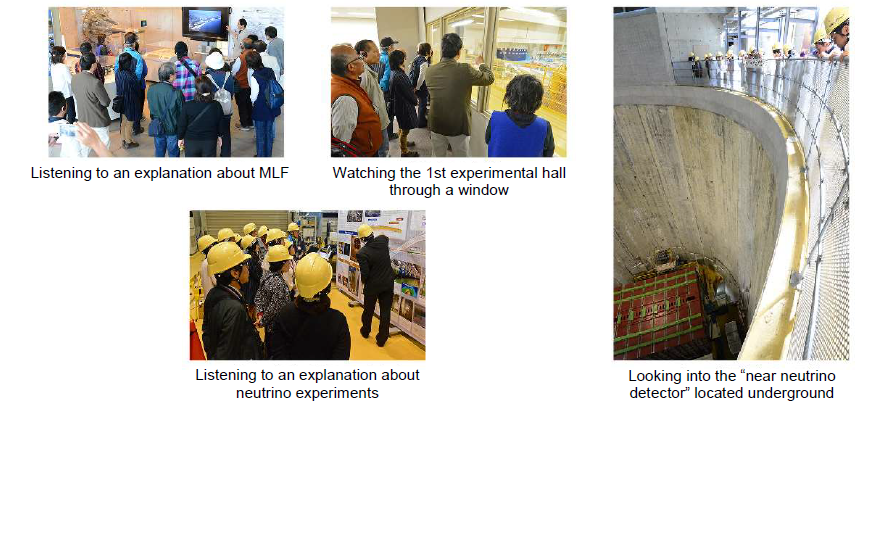
■Science for Adults "To the Secrets of the Pyramids and the Riddle of Space - The Front Lines of Research on the Muon* Elementary Particle" (May 9, Hitachi Civic Center)
The Science Museum of the Hitachi Civic Center is known, by everyone from kids to adults, as a "place you can learn interesting things about science while having fun." At a special event on May 9, Dr. Masashi Otani (Research Associate, KEK) of the Accelerator Division spoke to an audience of adults on the topic of "Research on the Muon Elementary Particle." A research team of Dr. Otani and others is carrying out planned experiments at J-PARC to measure the anomalous magnetic moment (g-2) with extremely high precision. The talk began with familiar topics, such as the new discovery of internal structures inside the pyramids by "looking through" them with cosmic ray muons, and the ability to predict volcanic eruptions by monitoring volcano magma. Then he covered topics like expectations for solving riddles of space such as dark matter thanks to the world's first successful acceleration of muons in the g-2 experiment. *The mu particle is called a "muon."
■CROSS, the Registered Institution for the Specific Neutron Beam Facility at J-PARC, Concludes Cooperation Agreement with the Institute for Materials Research, Tohoku University (Signing Ceremony on April 4, Institute for Materials Research / Sendai)
On April 4, a ceremony was held to sign a cooperative agreement promoting materials science research using neutrons. The agreement was signed by the Comprehensive Research Organization for Science and Society (CROSS), an organization promoting shared use of the neutron research facilities at J-PARC, and the Institute for Materials Research, Tohoku University, a center for joint use/research in the field of materials science. CROSS was selected by the Minister of Education, Culture, Sports, Science and Technology as the Registered Institution for the Specific Neutron Beam Facility at J-PARC, and since FY2011 has been involved in activities to promote use of the public neutron beamlines (currently 7 lines) of the Materials and Life Science Experimental Facility (MLF). The Institute for Materials Research has also installed neutron instruments at J-PARC and the JRR-3 research reactor facility of the Japan Atomic Energy Agency, and starting this fiscal year, will put the experimental instruments at J-PARC into full-scale operation, and commence research using neutrons. With the signing of this cooperative agreement between the two institutions, there is expected to be further development of research collaboration, greater promotion of personnel exchanges, and progress in materials science research over a wide range of topics using the reactor neutron source and high intensity pulsed neutron source.
■Formation of First Industry-Academia Collaborative Consortium at J-PARC (Launch Ceremony on April 5, Koku Kaikan / Tokyo)
An industry-academia collaborative "Functional Polymer Consortium" has been formed by five corporate groups led by, respectively, Kuraray Co., Ltd., Sumitomo Bakelite Co., Ltd., DIC Corporation, Nissan Chemical Corporation, and Mitsui Chemicals, Inc., and an academic research team made up of Kyushu University, Nagoya Institute of Technology, Mie University, and KEK. The consortium began operations on April 1, and this is the first industry-academia collaborative consortium at J-PARC. KEK Professor Toshiji Kanaya, Head of the Materials & Life Science Division will be involved, and Shin Fukuda, Managing Executive Officer of Mitsui Chemicals, Inc., will serve as representative. Operation of the consortium was entrusted to CROSS. With the cooperation of the J-PARC Center, the consortium will use the public beamlines at MLF to develop evaluation equipment specialized for evaluation of functional polymer materials, and next-generation functional polymer materials such as materials for fuel cells.

